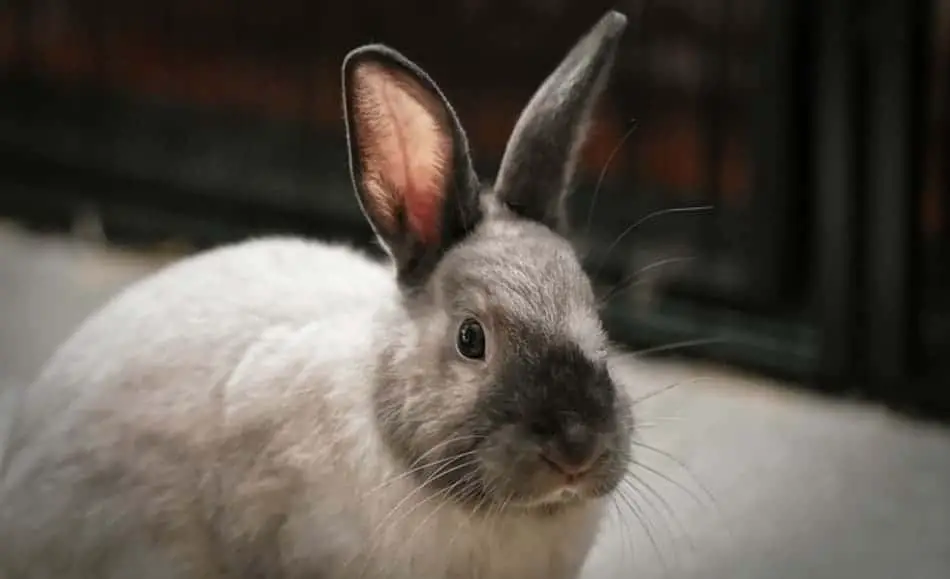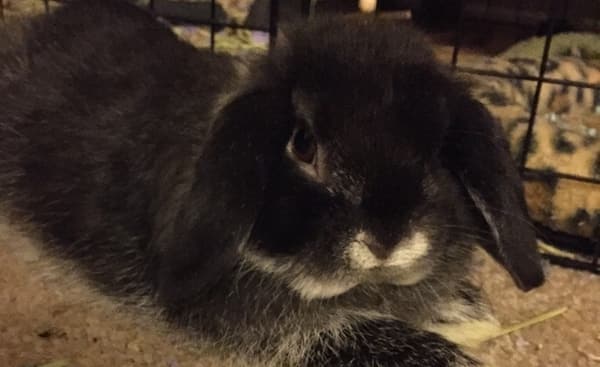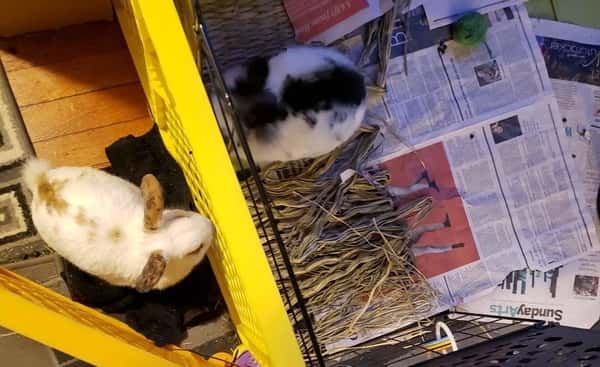House training a rabbit is surprisingly easy as rabbits are naturally tidy animals. However, it can take some trial and error to discover what kind of litter, bedding, and/or cage liners work best for you and your bunny. Rabbits with health or incontinence issues may also require a different setup than a fully-functioning bun.
So, can you use puppy pads for rabbits? In some situations, and for certain rabbits, puppy pads may be safely used as cage liners or an extra layer of moisture absorption. For most rabbits, however, there is a risk that they will ingest the plastic and stuffing that make up the pads, possibly leading to an intestinal obstruction.
This article will supply an in-depth explanation of when and how you may safely use puppy pads for a rabbit. It will also discuss the conditions most likely to make puppy pads an okay choice and the best type of puppy pads to use for rabbits, as well as safer options for absorptive litter, bedding, and cage liners.
Why Puppy Pads Are Risky for Rabbits
Puppy pads are often made of plastic and filled with absorptive stuffing. For some rabbits, they are an irresistible temptation to chew. This is dangerous for several reasons as rabbits and their digestive systems are quite delicate. First, ingesting plastic or stuffing could cause a blockage in your rabbit’s stomach or intestines.
GI Stasis
Puppy pads are designed to soak up as much liquid as possible, making them especially dangerous should your rabbit ingest them. This will cause them to swell in your rabbit’s stomach. A rabbit that has ingested part of a puppy pad may show signs of pain, constipation, and loss of appetite.
If the plastic or stuffing is obstructing the rabbit’s digestion, it may go on to cause gastrointestinal stasis. This occurs when a rabbit’s digestion stops, either from an imbalance of healthy bacteria or a blockage caused by indigestible material, and it can be fatal if not treated in time.
Harmful Chemicals
There is also a risk of your rabbit reacting to toxins in puppy pads. Some pads are treated with fragrances intended to disguise the unpleasant scent of urine. Others are treated with chemical pheromones intended to attract a dog to use them. These chemicals are likely to irritate your rabbit’s sensitive sense of smell and may cause an allergic reaction.
When Puppy Pads Make Sense for Rabbits
There are instances where it may make sense to use puppy pads for a rabbit. The key to avoiding the risks mentioned above is to be sure your rabbit cannot come into direct contact with the pad. You will need to watch carefully at least the first few times you use them to be sure your rabbit cannot get to them and chew them.
Disabled Rabbits With Incontinence Issues
Puppy pads have been used successfully for older or disabled rabbits with incontinence issues. Their super absorption qualities are a positive in this situation as it helps to maintain a clean and dry area, keeping the bunny comfortable while preventing aggravated issues like urine scald.
Caution should still be exercised to be sure the rabbit does not come into direct contact with the pad. The puppy pads should be used as the bottom layer of a multi-layered bedding arrangement.
They can be covered with old towels or a layer of litter and finally a layer of fleece. This will create a cushioned area for your older or disabled bunny to rest that efficiently soaks any urine away from it, drawing it down into the puppy pads.
An Unreachable Cage-Liner
If your rabbit’s cage has a removable tray that is separated from the cage enough that your rabbit can’t get to it, you could conceivably use puppy pads to line this area. You would still want to steer clear of any scented or otherwise treated pads and be absolutely sure your rabbit can’t get its teeth on them.
Puppy pads still may not be the best choice in this situation. First, a rabbit should not be spending too much time in a cage with a raised wire floor as this can irritate its feet and cause sore hocks. Additionally, they are a somewhat expensive option as a cage liner. More economic ones are readily available.
Bottom Layer of a Litter Box
If you need extra absorption in your litter box, you can use puppy pads at the bottom of the box. Again, they will need to be covered with a layer of newspapers or litter to keep your rabbit from chewing on or eating them, and this may not work for rabbits with a penchant for digging in the box.
You should also be cleaning your rabbit’s box often enough that there is not a large amount of urine to deal with.
Washable, Cloth Puppy Pads
Probably the safest type of puppy pad to use for a rabbit is a washable, cloth pad. These washable pee pads for rabbits offer a practical solution as your rabbit is less likely to access the stuffing within them, minimizing the risk of ingesting any plastic during a nibbling session.
The fact that they can be reused also makes them more economical than disposable pads. You will still need to watch your bunny closely to be sure it doesn’t nibble through the cloth and ingest any of the absorptive filling as this could still lead to an emergency vet visit.
What to Use Instead of Puppy Pads
Although puppy pads occasionally may have their place in keeping your rabbit’s area clean, there are fortunately many other litter and bedding options with lower risks. There are also a few other litter options you should avoid.
Safe Rabbit Litter and Bedding Options
Safe options for lining a litter box or cage are low on dust, high on absorption, and fairly easy to find and use. Some are better than others, which is why we’ll discuss the pros and cons of each.
– Aspen or hardwood shavings—These are inexpensive and easy to find. They also absorb urine well. On a more negative note, they don’t do much to counteract odor, they tend to stick to rabbit fur—thus ending up all over the house—and they get sodden and need replaced often.
– Recycled/Paper-based bedding—This type of litter has become more popular in recent years for good reason. It is natural, absorbent, doesn’t get tracked around the house, and keeps odors down fairly well. It can be expensive, and you’ll need to look for a brand that does not include baking soda. Although baking soda helps absorb odors even more, it can irritate your rabbit’s respiratory system.
– Newspaper—This option’s biggest draw is that it is cheap and easy to come by. Its absorption is decent, but it will need to be replaced often. It can also be a problem if your rabbit tries to chew or eat it. Newspaper can make a good bottom layer if you need more absorption in your litter box or cage.
– Corn cob litter—Again, this is a litter that is inexpensive, easy to find, and absorbs well. Like wood shavings, it does tend to get tracked around the house. It also has the potential to be dangerous if your rabbit decides to eat large amounts of it. You can discourage this by adding a layer of hay on top to keep your rabbit busy while it’s using the box.
– Cotton towels, fleece blankets, hay, and straw—If you’re looking for more of a soft, absorptive bedding, these are all safe, manageable options.
Unsafe Litter Options
Like puppy pads, these litter box fillers are not recommended for rabbits for many of the same reasons. Some are more dangerous if consumed than corn cob or paper because of their solid clumping qualities. Others contain irritants to your bun’s sensitive system.
– Pine or cedar shavings—Unlike aspen or hardwood shavings, pine and cedar have a strong odor and dustiness that have been linked to respiratory issues and even liver damage in small animals that spend too much time around them or consume them.
– Cat litter—This litter is completely indigestible, often contains chemicals or scents, and clumps easily, making it almost certain to block up your rabbit’s digestive system if it is ingested.
– Clay litter—Again, this litter clumps easily, making it very dangerous for your rabbit to eat. It’s also very dusty, which can cause respiratory issues.
Conclusion
With all of the risks involved, you should avoid using puppy pads whenever possible. As you can see, there are plenty of other options available.
However, you know your rabbit, and if pads still sound like the best choice to keep it clean and comfortable, just be sure to choose a sturdy, unscented brand—reusable cloth is best—and take precautions to ensure your rabbit does not chew or ingest any particles.
Layers are one of the best ways to keep your rabbit away from a more hazardous liner while getting maximum absorption, and a top layer of hay never hurts as it gives your rabbits something else to chew on.




